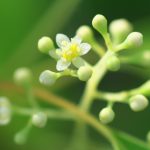Last summer, I found Saga-grown mandarin oranges for sale at a vegetable and fruit store in Tokyo. A pack of five mandarin oranges was priced at 560 yen. I considered for a while whether or not to buy them, but finally picked up a pack and paid the money to the cashier. Those mandarin oranges tasted sweet-and-sour, and delicious. They tasted the same as the mandarin oranges I eat in Saga. If I had paid the same amount of money in Saga in winter, I could have gotten many more mandarin oranges. Off-season mandarin oranges bought outside Saga were quite expensive.
Saga is a famous production center of mandarin oranges cultivated in greenhouses. The prefecture boasts the largest production of greenhouse-grown mandarin oranges in Japan. Originally, the season of mandarin oranges is in winter. But you can eat them in Japan throughout the year, because greenhouse-grown mandarin oranges are available. Mandarin oranges grown in greenhouses in Saga are sold from May to September, while ordinary mandarin oranges are available during the period from September to April. When the air begins to get cold in fall, the peak season of mandarin oranges starts. Mandarin oranges grown in Japan feature strong orange color, with no seeds in segments and not very large size. They taste very sour at first, and then sweet.
Among the famous brands of Saga-grown mandarin oranges is Tara Mikan. Tara Town is located in the southwest part of Saga Prefecture, facing the Ariake Sea. Mandarin oranges cultivated in Tara Town taste delicious by the grace of the local soil, water and climate. The town’s geographic and meteorological features, together with nutrition contained in the soil, help foster delicious mandarin oranges.

One day with the New Year just around the corner, I was choosing my favorites from among many mandarin oranges in rows at the roadside station in Tara. The store was filled with the hustle and bustle of many people who had visited it to buy items necessary for New Year. The store really has a wide lineup of mandarin orange varieties. My husband picked up one variety from among them, and had me taste it. I found the variety was named “Seawater Mikan,” because surprisingly seawater is used to grow it. Before trying it, I wondered if this name was intended to emphasize the variety’s uniqueness, and if it would taste salty, but it tasted sweet-and-sour and delicious.
A quick survey taught me that this mandarin orange variety is produced by an organization named Saga Western Colony through a project using the seawater of the Ariake Sea. The Ariake Sea has tidal flats with a gap of 6 meters between high and low tides during the day. The unique mud of the tidal flats contains various nutrients. Therefore, mandarin oranges showered with the nutritious seawater drawn from the Ariake Sea grow sweet and delicious. It sounds interesting!
If you visit Saga in winter, you can encounter many varieties of tasty mandarin oranges. There are a wide variety of mandarin oranges here, including both large and small ones, as well as Seawater Mikan. How about selecting and buying your favorite ones?

Author name: Noi
Hometown: Bangkok, Thailand
I live in Wakaki-cho, Takeo City, Saga Prefecture, together with my Japanese husband, raising our child.
In Thailand, I used to do art and publication-related work.
I have a Kyushu Special Zone Guide-interpreter’s license (in Thai).

 TH
TH KR
KR JP
JP

